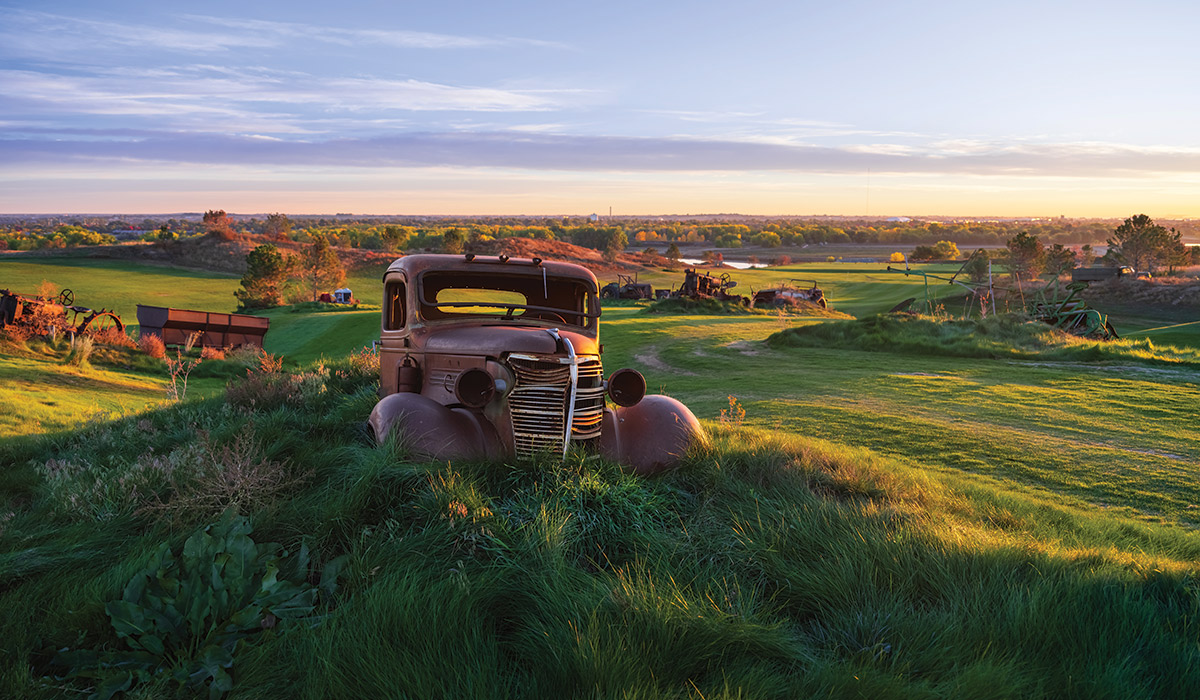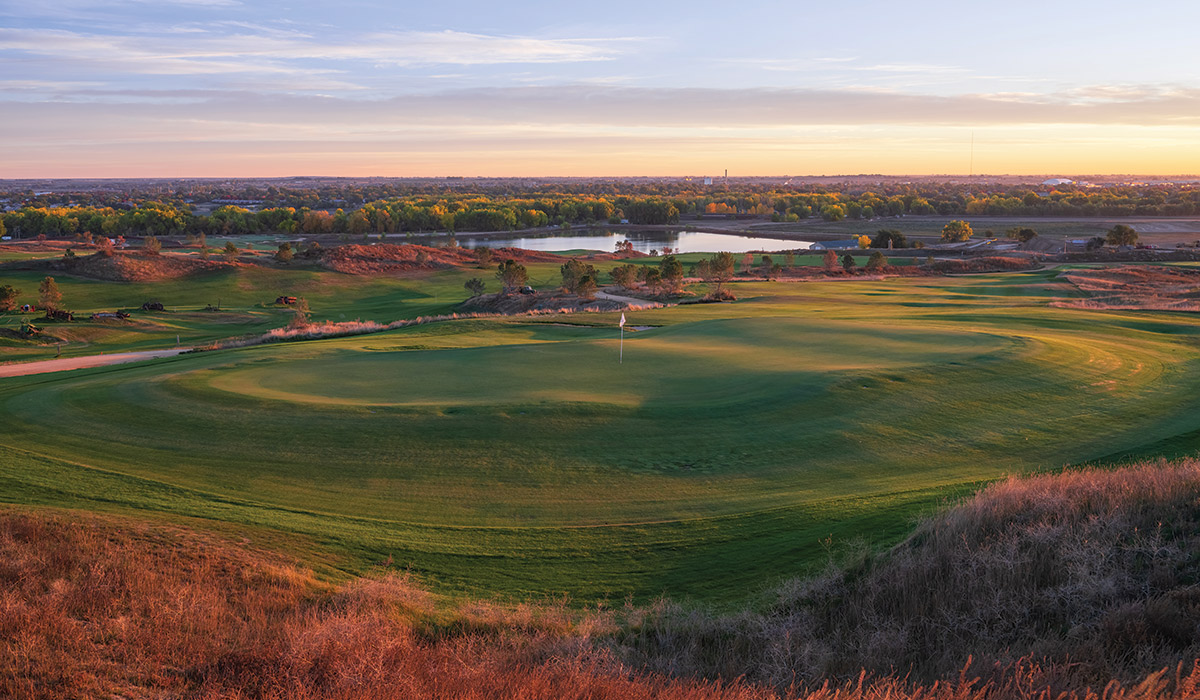
indsor, Colorado, is not in the mountains. Not exactly. Technically speaking, the city sits in the Front Range, a vast high plains area in front of the mountains. What that means for golf course developers is that there’s a lot of land to work with, and in the case of RainDance National Resort & Golf, that is a very good thing.
RainDance opened this July and though the acclaim has been huge, we’re not sure it begins to match the hugeness of the course itself. Originally planned to have a total yardage in the “high 7,000s,” as course architect Harrison Minchew told us, the end product was somewhat larger.
“As we started seeing the elevation changes in the holes, and the fact that we wanted to use fescue grass that we could dry out so the ball would roll quite a bit,” he said, “it became obvious that the course needed to be longer.”
In the end, Minchew said that he and design consultant (and eight-time winner on the PGA Tour) Fred Funk pushed the course to 8,465 yards: “Not the largest in the world,” he points out, “but the largest in North America.”
“We had it around 8,000 and we realized if we ever had a tour event, that was going to play too short,” explained Funk, who also has nine PGA Tour Champions wins. “We have 250 feet of drop and we’re at 5,000 feet so Martin [Lind], the developer, said, ‘Why don’t we have the shortest golfer to ever play on the PGA Tour design the longest golf course?’ I went, ‘Really?!’”
Funk was joking, of course (and at 5’ 8” he’s the same height as Francesco Molinari and nearly three inches taller than Gene Sarazen was). Regardless,
anyone could feel small standing amidst the epic landscape at RainDance.
“There’s no denying it was built for the best players in the world,” said Chris Williamson, RainDance’s head golf pro. “It’s challenging, but there’s nothing unfair about it. You look at No.2, it’s a big, slightly downhill turn-to-the-left par-5. It’s really pretty to look at and there’s a huge landing zone with bunkers on each side should you miss. With the scale we have up here and with the hill, it feels narrow, but if you get out there
and measure it’s actually a 60-yard-wide fairway.”

Various experts have their own numbers, but the general consensus regarding the effect of altitude on ball flight has the distance increase (due to the thinner air) at something like an extra 2.5 yards of driver per 1,000 feet of altitude. Add to that some fairly dynamic topography, with arroyos and washes throughout, and there were some puzzles to solve.
“The challenge of designing the course was there, not just from an altitude standpoint but there’s about 225 feet of elevation changes across the site,” Minchew explained. “That’s not a whole bunch, but it’s somewhat significant. As far as routing the holes to prevent us from having anything over-the-top uphill or downhill, I’ll have to say that Ed Seay, that’s what he taught us the most, how to route on this kind of topography.”
In the past, Minchew worked with the Arnold Palmer Design Company on many projects and referenced his time there working with Palmer’s course design partner, Ed Seay, as informative for the RainDance project.
“I did 15 golf courses in Japan so I was used to pretty severe topography,” he said. “And the way you flatten holes out on a steep site is that you make the elevation changes between the holes. I think it plays about 30 feet uphill total, if you average the holes out. That’s something I’m proud of, and again it’s something I learned from my tutelage working for Arnold Palmer.”
Adding another Palmer element to the project, Minchew brought in Randal Pichon of Michigan-based Eagle Golf Construction, a top contractor who worked with the Palmer crew back in the day. Additionally,

Ed Seay’s son, Mason, a video producer, was brought in to document the project. And if that wasn’t enough, Palmer’s grandson, PGA Tour golfer Sam Saunders, lives nearby and currently holds the course record at RainDance with a 67.
“Sam played twice from the backs and shot 67 one day and 68 the other,” Funk said, “so it can be done. I’m old and broken down and can’t play from the backs—but tried to—but we really emphasize playing the right tees.”
“Some holes have 10 different tee boxes,” Williamson explained. Harrison did a great job of being able to move tees around based on the weather. If the wind is up or if it’s not, if they really want to move stuff around, setting it up for an event or a tournament, they can configure it where you’re not playing to the rating.
“If you’re trying to go bold and you go back too far, it’s a very demanding golf course. But if you play the right set of tees and land the drive where the hole is designed to have the drive land, it plays really fun. A 300-yard drive could see 50 feet of roll. Even a 100-yard drive could see 30 to 40 feet, so we emphasize playing the right tees.”
Funk said the terrain was left alone as much as possible, and so the experience of RainDance is quite natural and rustic. “Those natural arroyos and all are very special,” he said. “They’ve been there for thousands of years; we just tried to go around and over them.”
The result is a lot of golf course with a lot of natural beauty, big distances, big demands and big rewards. If you play the right tees, we’re guessing the smile on your face will be absolutely huge.
Follow Us On


| Cookie | Duration | Description |
|---|---|---|
| cookielawinfo-checkbox-analytics | 11 months | This cookie is set by GDPR Cookie Consent plugin. The cookie is used to store the user consent for the cookies in the category "Analytics". |
| cookielawinfo-checkbox-functional | 11 months | The cookie is set by GDPR cookie consent to record the user consent for the cookies in the category "Functional". |
| cookielawinfo-checkbox-necessary | 11 months | This cookie is set by GDPR Cookie Consent plugin. The cookies is used to store the user consent for the cookies in the category "Necessary". |
| cookielawinfo-checkbox-others | 11 months | This cookie is set by GDPR Cookie Consent plugin. The cookie is used to store the user consent for the cookies in the category "Other. |
| cookielawinfo-checkbox-performance | 11 months | This cookie is set by GDPR Cookie Consent plugin. The cookie is used to store the user consent for the cookies in the category "Performance". |
| viewed_cookie_policy | 11 months | The cookie is set by the GDPR Cookie Consent plugin and is used to store whether or not user has consented to the use of cookies. It does not store any personal data. |